The Intel Broadwell Xeon E3 v4 Review: 95W, 65W and 35W with eDRAM
by Ian Cutress on August 26, 2015 9:00 AM ESTProfessional Performance: Windows
Agisoft Photoscan – 2D to 3D Image Manipulation: link
Agisoft Photoscan creates 3D models from 2D images, a process which is very computationally expensive. The algorithm is split into four distinct phases, and different phases of the model reconstruction require either fast memory, fast IPC, more cores, or even OpenCL compute devices to hand. Agisoft supplied us with a special version of the software to script the process, where we take 50 images of a stately home and convert it into a medium quality model. This benchmark typically takes around 15-20 minutes on a high end PC on the CPU alone, with GPUs reducing the time.
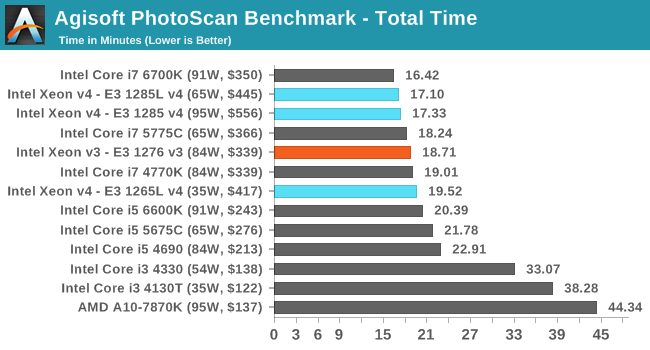
The benefits of the eDRAM here afford nearly two minutes over the v3.
Cinebench R15
Cinebench is a benchmark based around Cinema 4D, and is fairly well known among enthusiasts for stressing the CPU for a provided workload. Results are given as a score, where higher is better.
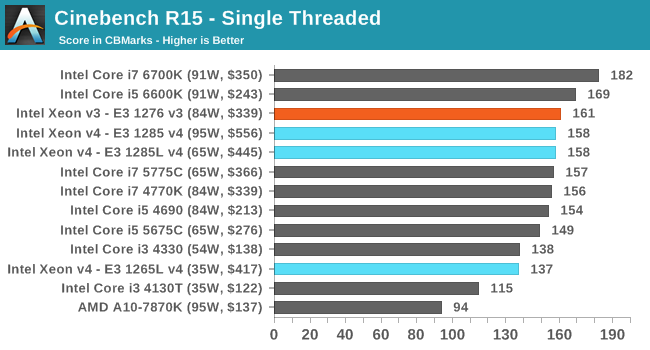

We've seen that Broadwell can organise threads slightly better than Haswell, along with its IPC increases and ability to manage more data in its buffers. As a result, while single thread is pretty much par for the course between the v3 and v4, the multithreaded result puts the v4 ahead of the v3.
HandBrake v0.9.9: link
For HandBrake, we take two videos (a 2h20 640x266 DVD rip and a 10min double UHD 3840x4320 animation short) and convert them to x264 format in an MP4 container. Results are given in terms of the frames per second processed, and HandBrake uses as many threads as possible.
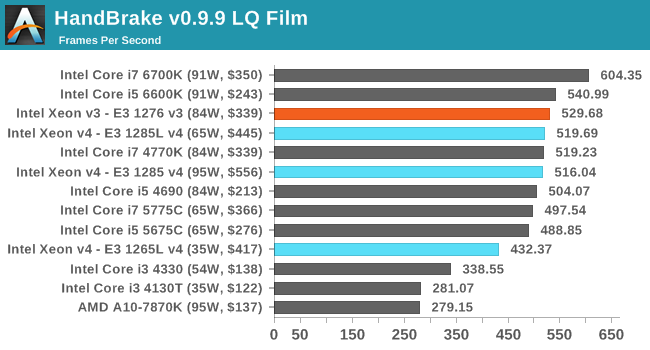
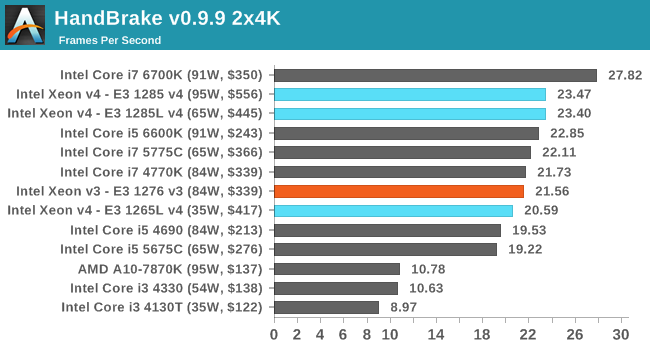
With our HandBrake tests, historically low quality encodes with small frames require a purely faster processor, whereas large high quality frames need more memory accesses. This is why the E3 v3 at 84W and E3 v4 at 35W come out near similar - the eDRAM of the v4 helps push a little ahead here. That being said, the improvements in Skylake show what perhaps the future v5 Xeons might be capable of.
Hybrid x265
Hybrid is a new benchmark, where we take a 4K 1500 frame video and convert it into an x265 format without audio. Results are given in frames per second.
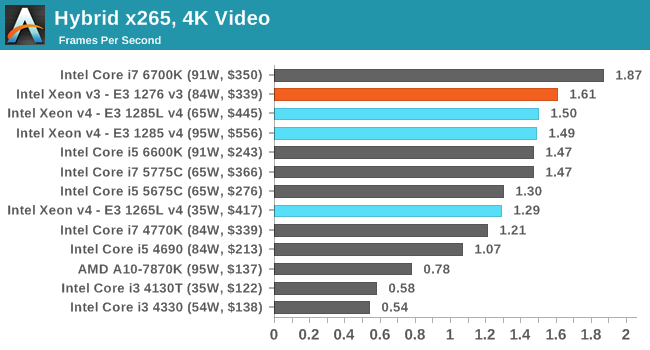










72 Comments
View All Comments
lilmoe - Wednesday, August 26, 2015 - link
+1I'm looking forward to the new mobile Xeon chips and would love to see that too.
Ian Cutress - Thursday, August 27, 2015 - link
Working on it! :)satai - Friday, August 28, 2015 - link
Great to hear that.Atari2600 - Wednesday, August 26, 2015 - link
Ian,Primarily in the graphs you compare a 1276 v3 to two flavours of 1285 v4.
But, on the first page, you tabulate the 1285 v3 and 1265 v3.
Would it be possible to include the 1276 v3 in this table?
Just quickly looking at ark.intel; the 1276 v3 has a box price of $350 and seems otherwise identical to the 1285 v3. On the face of it, it appears a disruptor.
Cheers
Brendan
lilmoe - Wednesday, August 26, 2015 - link
That's one hell of a 35W chip. Not bad at all.jamyryals - Wednesday, August 26, 2015 - link
Why does the 95Watt part exist? I don't get it.Gigaplex - Wednesday, August 26, 2015 - link
And why does the 65W chip consume more power than the 95W one?Oxford Guy - Wednesday, August 26, 2015 - link
Because Intel's power consumption ratings are a load of nonsense often enough. And AMD isn't always accurate either. The 8320E, for instance, is rated 95W but actually used 86 in Anandtech's tests. The 8370E is rated 95W but used 107 or something. The 9590 is even further away from its rating.But, Intel is the one gaining the most from this deceptive marketing since people know AMD's FX chips are power-hungry due to being on 32nm and not having had as much money invested in hand-tuning to lower power. So, Intel underestimates the consumption of parts like the 4790K to make its chips seem even more dramatically efficient.
Yuriman - Thursday, August 27, 2015 - link
There's one problem with this: TDP is not "power consumption", but "Thermal Design Power". A chip with a 95w TDP needs to function in an environment designed to dissipate 95w of heat over a given period of time. CPUs can go well over this for short periods.Oxford Guy - Thursday, August 27, 2015 - link
Short periods are one thing. False advertising is another.